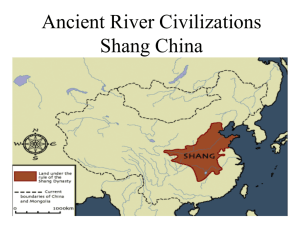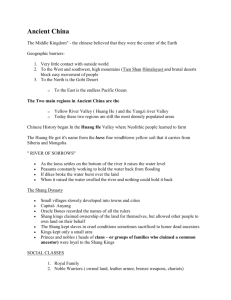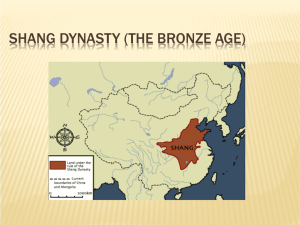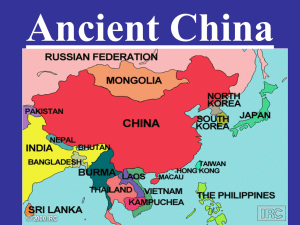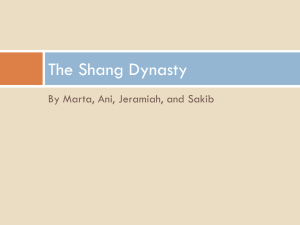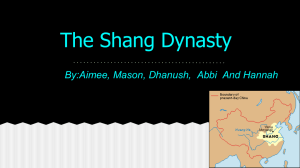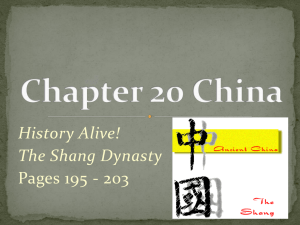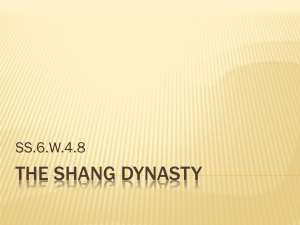Shang and Zhou Graphic Organizer
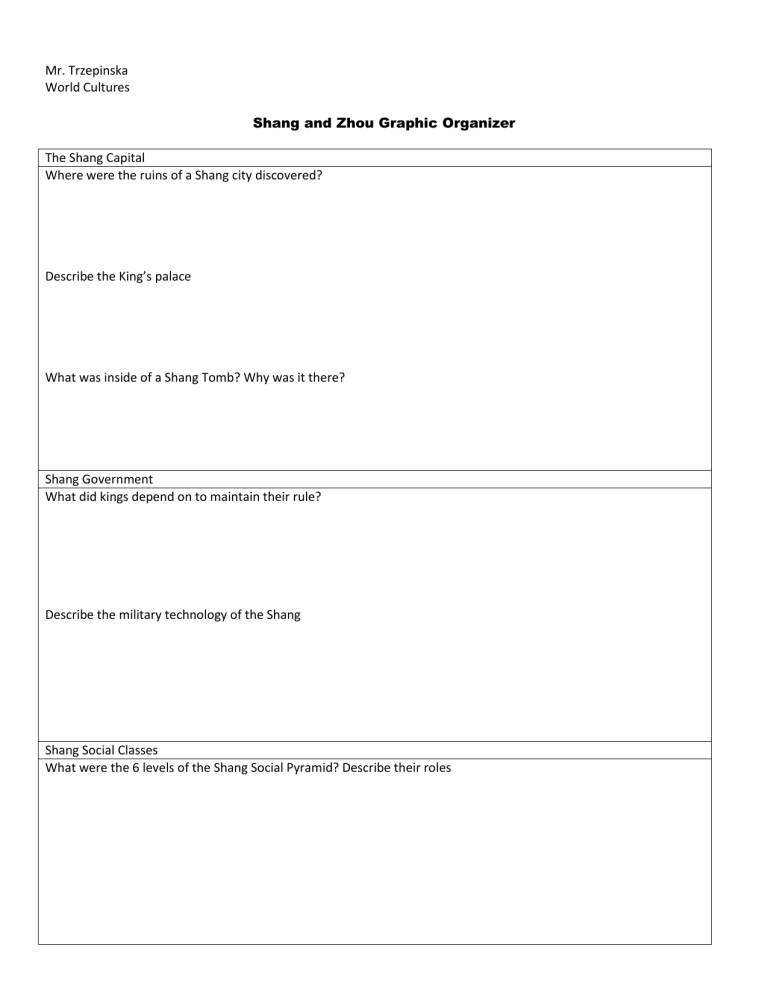
Mr. Trzepinska
World Cultures
Shang and Zhou Graphic Organizer
The Shang Capital
Where were the ruins of a Shang city discovered?
Describe the King’s palace
What was inside of a Shang Tomb? Why was it there?
Shang Government
What did kings depend on to maintain their rule?
Describe the military technology of the Shang
Shang Social Classes
What were the 6 levels of the Shang Social Pyramid? Describe their roles
Shang Religion
What is ancestor worship? Why did the Shang practice it?
What are oracle bones? How were they read?
Shang Writing, Art, and Technology
What are pictographs and logographs?
Identify two materials used by Shang artists. For each material give an example of an art piece that might be created using it.
Describe ways that Shang artists decorated objects
Name the types of weapons that Shang made out of bronze
-
-
End of the Shang Dynasty
-
Identify and explain 3 reasons that led to the end of the Shang Dynasty
The Zhou Dynasty
Explain the role of King, Lord, and Peasant in Feudalism
King
Lord
Peasant
What caused the Warring States period?
A Shang Capital City
When archaeologists began excavating the ruins at Anyang in 1928, a great deal was learned about the
Shang culture. The city included a palace, a temple, and houses. There were also workshops for artisans who created objects made of metals, pottery, stone, and jade.
The king’s palace sat on a platform. The palace was built of mud-plastered walls held up by wooden posts. Beneath its foundations, archaeologists found human bones. The bones suggest that the Shang performed human sacrifices when they constructed a new royal house.
Human sacrifices were also part of Shang burials. While excavating at Anyang, archaeologists found at least nine royal tombs. Each tomb had a large pit with ramps leading down to it from the north and south. When a king was buried, slaves, servants, and animals were led down the ramps into the pit. There, they were sacrificed as part of the Shang belief that the king must continue to be served in the afterlife.
This belief in life after death is likely the reason that metal vessels and containers of food were also buried with or near Shang kings. The treasures found in royal tombs include many weapons, carved jade ornaments, bone carvings, pieces of pottery, stone sculptures, and even chariots.
Shang Government
The Shang government was led by a powerful king. To extend his power, a king set up smaller kingdoms led by his younger brothers and nephews. When a king died, his power was often preserved by passing it to a younger brother or to a son.
Shang kings depended on strong armies to maintain their rule and to defend and expand their kingdoms. The kings took part in almost constant warfare with their enemies and fought to keep other clans under control. Prisoners of war were used as laborers and in human sacrifices.
The king’s armies were especially powerful because Shang nobles had weapons made of bronze . The
Shang were among the first civilizations in the world to discover how to make bronze from a mixture of copper and tin.
Shang armies were made up of large numbers of foot soldiers, archers, men mounted on horses and elephants, and fighters in chariots. The chariots were two-wheeled carts drawn by horses. Three soldiers rode in each chariot. The driver stood in the middle, with a spear carrier to his left and an archer to his right. Shang armies must have been a terrifying sight to their enemies.
Shang Social Classes
Nobles After the ruling family, the nobles made up the highest- ranking social class. Nobles fought in the king’s armies. In exchange for their military help, the king was unlikely to interfere with the nobles’ control over the land.
Shang nobles enjoyed a life of luxury. They lived in great palaces and spent time hunting. The king often gave nobles symbols of power, such as jade discs. The discs might be decorated with a “lucky” creature such as a dragon or tiger. Nobles often mounted the discs on posts in their homes.
Artisans This talented group formed a small social class that included potters, stonemasons, and workers crafting items of bronze and jade. These skilled workers had lower status than nobles but higher status than farmers.Artisans skilled in bronze were especially valued. They made the weapons used by Shang warriors. They also made and decorated containers for the king and his nobles to use in religious ceremonies, or simply as symbols of their wealth.
Traders Like artisans, those who were traders ranked below nobles but above farmers in Shang society. Scholars believe that the Shang traded extensively. The Shang also used cowrie shells, a type of seashell, as money. The shells were valuable because they came from far away. The Shang people had to trade with neighboring regions to get them.
Farmers Farmers made up the largest social class in Shang society. They worked small plots of land, growing millet, wheat, barley, rice, fruit, vegetables, and nuts. They did not own the land they farmed.
Farmers gave most of their harvest to the nobles, who sent a portion to the king. Farmers could keep only enough food to feed themselves and their families.
Slaves At the very bottom of Shang society were slaves. Many of these slaves were prisoners of war. They spent their lives building tombs and palaces. When their masters died, the slaves were sometimes sacrificed, in keeping with the Shang belief that slaves should continue to serve their masters in the afterlife.
Shang Religion
Shang religion centered on ancestor worship . The treasures buried in kings’ tombs show that the Shang believed in a life after death. They also believed that dead ancestors had the power to help or harm the living. For this reason, the Shang honored their ancestors. As signs of respect, worshippers gave offerings of food, and sometimes made human sacrifices.
The Shang believed that their king’s relationship to ancestral spirits had special significance. The king inherited the right to rule from his ancestors. And among the king’s responsibilities was a duty to follow the wishes of his ancestors.
Kings used oracle bones to seek their ancestors’ advice on important matters such as when to hunt, where to build cities, and whether to go to war. The oracle bones were made from turtle shells or the shoulder blade of a cow. To ask a question, a holy man would make a statement such as this:
“Tomorrow is a good day for the hunt.” Then he would press a hot needle against the back of the bone. The heat would make the bone crack. The pattern of the crack was believed to be a message, which the holy man or king would translate. The holy man might then carve the message on the oracle bone
Shang Writing
The inscriptions on oracle bones are among the earliest known examples of Chinese writing. In Shang writing, as in modern Chinese, characters stand for words rather than sounds. Early Chinese writing contained only pictographs, images that stand for objects. By the Shang dynasty period, people were also using logographs, characters that stand for words. Having a written language helped unify the Chinese people. Although spoken language varied from place to place, people of the upper classes used the same written language
Shang Art
Shang artists showed great skill in working with bronze. Shang artisans made beautiful vessels and other objects. Some bronze vessels had geometric designs and pictures of mythical creatures. The most common picture was an animal mask, it might have the horns of an ox, the ears of an elephant, the talons of a bird, the eye of a man, and the crest of a dragon. Some scholars say that these masks were symbols of all the beings in the world.
The Shang also produced remarkable jade pieces. Jade is a very hard stone. Workers made jade objects by sawing, filing, and sanding the stone.
The Chinese may have believed that the qualities of jade represented the qualities of a superior person. The hardness of jade stood for wisdom. Jade was also smooth and shiny. These qualities stood for kindness.
Shang Technology
Working with bronze was an important technology for the Shang. Artisans used bronze to make many tools of war. These included arrowheads, spearheads, ax heads, and helmets. The bronze making skill of the Shang is one of the reasons they were able to remain in power for more than five hundred years.
The End of the Shang Dynasty
The Shang excelled in war, enabling the ruling classes to build up great wealth. But, in time, these very strengths helped to bring about the end of the dynasty. Constant warfare eventually weakened the military power of the Shang.
The Shang had a system of money, using valuable cowrie shells that they received as part of their extensive trade with neighbors. The Shang king and his nobles spent extravagant amounts of money on their palaces, furnishings, clothing, and even their tombs. Over time, this lavish spending may have weakened the economy. A later king would say that the final blow was the corruption of the last Shang king. Rather than look after his people, he spent all his time on recreational activities like hunting. But no one knows whether this report was true.
Around 1045 B.C.E., a frontier state called Zhou (joh) rose up against the dynasty. Zhou armies under
King Wu caught the Shang unaware, defeating and overthrowing them. One story says that, as Zhou rebels stormed his capital city, the last Shang king ran from the battlefield, put on all his jewelry, and threw himself into the flames of a fire.
The Zhou Dynasty
Around 1045 B.C.E., the Zhou, a group of people in northwestern China, moved into the central plains. They overthrew the Shang dynasty and established a new dynasty. For several centuries, the Zhou dynasty ruled over a group of states in China. But in the later years of the dynasty, wars between these states plunged China into disorder.
The Early Years: Stability and Feudalism
Using a system of relationships called feudalism , the Zhou increased the stability of the government. Under feudalism, the king owned all the land. He gave large pieces of the land to loyal supporters, called lords. In exchange, these lords sent soldiers to fight against enemies who threatened their king. The lords were rulers of their own lands, or states. They had absolute power over the peasant farmers who worked those lands. Peasants had their lord’s protection. In return, they gave a portion of their crops to the lord.
The Later Years: Conflict and Creative Thought For a time, feudalism maintained political stability in
China. But by the 700s B.C.E., the system was starting to break down. The lords of individual states became more ambitious and more powerful. Eventually, the power of some lords rivaled that of the king.
Between about 770 and 453 B.C.E., a number of small states often quarreled with one another. They eventually grouped into six or seven larger states that fought for power. These wars brought some 250 years of disorder to China. This historical time is often called the Warring States period.
Such unrest led Chinese thinkers to ask important questions about human nature and about how best to govern. Some rulers hired scholars to advise them on how to create order and increase their royal power.
